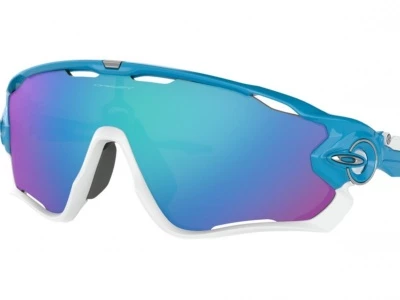Clear vision is as important for cyclists as having strong legs and powerful lungs so wearing the right sunglasses is vital.
It's rare to see road racers or trail bikers, toting metal-framed aviators. It may look stylish, but metal is a poor choice for sportswear.
Metal frames will not fit snugly around the face while polycarbonate and nylon infused plastics are strong, flexible lightweight and sturdy.
Plastics are less likely to shatter on impact and are easier to mould into a wrap-around fit that hugs the face.
Boost the contrast to aid vision
One way to improve vision while cycling is to use glasses lenses that enhance contrast, especially in areas of the light spectrum that are most prevalent on the open road.
Increasing contrast helps the rider to see light objects against a dark background, a typical situation on the road in normal lighting conditions.
High contrast can be most beneficial when riding at higher speeds when the cyclist will need to anticipate hazards and react more quickly to avoid problems.
Good contrast in the lenses also helps the rider to track moving objects, a huge advantage on busy roads or when out with other cyclists.
Tinted lenses can provide extra contrast, but it's vital that the rider chooses the one that suits them best for the typical sort of riding they intend, as appropriate contrast levels can be quite subjective.
Brown tinted lenses will help cut glare and are excellent for mountain biking or trail riding.
Grey tints are not so good at improving overall contrast, and they are less likely to distort colours. They are best for sunny, bright days.
Amber tints can increase clarity and brighten colours; particularly useful on dark or stormy days.
Reddish tints are useful for adding contrast in low light conditions and make another useful choice for cloudy days or when rising wooded trails.
Whatever the tint, it's a good idea to check for a tag that spells out the light-absorption levels, or the opposite, the transmission factor.
Keep safe from flying debris
Snug fitting sunglasses are essential to keep flying debris out of the eyes while cycling.
Some riders refuse to wear glasses and prefer to tough it out even in high winds and driving rain. Not only are they in danger of causing permanent damage they are inviting trouble.
Insects, dust and dirt, are not only an irritant, but they can also hurt the eyes too. There is nothing quite like being hit in the eyeball at 20 mph by an insect flying in the opposite direction.
Not only can the rider expect pain but tears and blinking will often result from the impact, and these can interfere with vision at a critical moment.
The wind can dry out the eyes
Cyclists can be prone to dry eyes. It's caused by wind blowing directly into the eyes and evaporating moisture from the surface.
The result is sore eyes that can be an irritant and can affect your vision. Tears are not a great help as they are mostly composed of water which is rapidly blown away by the wind.
Part of the answer is to wear wraparound glasses that fit snuggly around the eye sockets.
Airflow is important here to keep the eyes ventilated and preventing the lens from fogging up with greater exertion.
An anti-fog coating will help, but many sports eyewear models now come with strategically placed vents that promote good airflow around the eyes even in the hottest conditions.
But wraparound glasses are not the perfect answer and sometimes the cyclist may need to apply a few lubricant eye drops before setting out.
Look out for UV Protection
Eyes are very sensitive to light and prolonged exposure to sunlight when out cycling can trigger a range of health problems.
Most are mild or temporary, but some can cause long-term damage so it makes sense to wear high-quality cycling glasses when out on the road.
The biggest consideration is the amount of protection from UVA and UVB light. Look for the label that guarantees 100 protection against ultraviolet radiation.
One piece wraparound lenses give the best UV light protection as they cut out harmful rays from the side as well as the front.
Reasons to buy sports performance eyewear
There are several good reasons to use sports performance eyewear when taking to the road. Cycling glasses are designed to wrap around the head and fully cover the eyes, meaning you get full protection.
Glasses designed for cyclists will also be better at staying in place especially when riding over bumps or when looking down at the road. Many performance sunglasses have a grip system to keep them in place.
An important feature of performance eyewear for cyclists is arm length. Glasses need to fit snugly under the helmet.
Some cycling sunglasses like Oakley's Jawbreaker have adjustable arms with different length settings to ensure a good fit with most helmets.
The lenses that are sold with cycling sunglasses are also often purpose-built for that activity. Many will have a large one-piece integrated lens which gives a greater degree of coverage and visibility as there is no gap on the nose bridge.
Single piece lenses also tend to wrap further around the side of the head, increasing vision and protection.
Single piece lenses for cyclists are also often interchangeable so that the same glasses frame is used when it's sunny or when the weather is not so good. The rider can easily take out the old lens and snap a new one into place.
Whatever the lens choice it's a good idea to pick one with an anti-scratch coating. A scratched lens not only interferes with vision it can let in damaging UV light.
An anti-scratch coating gives an added layer of protection and means the lenses will last longer.
Sports eyewear in the frame
There has never been more choice when it comes to ergonomic sports eyewear and models on offer today have been developed with a broad range of features and materials designed to make your cycling safer and more comfortable.
When it comes to fit, there is really no substitute for trying them out. Glasses should sit tightly against the face and rest comfortably on the nose, cheeks and forehead while the arms should grip the sides of the head firmly, but not too tight.
Check that peripheral vision is clear and that the frame does not impair vision, a particular advantage of one piece wraparound frames.
A secure fit is not only important when trying glasses on in the shop. The glasses will need to remain in place while out on the road so it's a good idea to shake the head up and down and side to side to ensure they won't slip off in more testing conditions.
There are dozens of performance eyewear models on the market, and they come in a remarkable range of styles and colours and priced at many levels. With so many to choose from, there is sure to be a pair that is just right, so take the time to choose the right ones for you.



